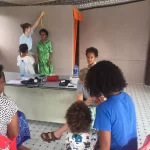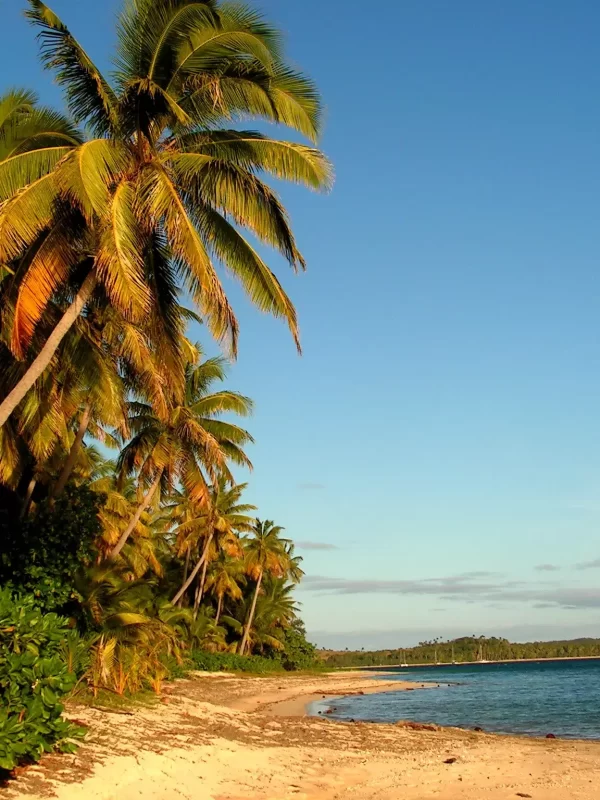Here is a transcript of a podcast by IVI’s Fiji Nutrition Coordinator. Here, Jules Galloway speaks about the work we are doing in Fiji, including the health checks and education for staff working at the 5* resorts in Fiji! Read on for more…
We’ve been over to Fiji a couple of times and we had an opportunity to work with some partners over there. One of those partners was quite unexpected actually, it was a 5* resort. At first, I was a little sceptical because we really didn’t come here to do corporate stuff but we came here to help people who were extremely needy. We happened to be doing health checks and working with the community that was opposite a 5* resort called Sheraton Tokoriki. They invited us to go over for the day and to do health checks on the staff who live out the back of the resort.
In turns out that a lot of people commute from nearby islands to go to work but also, if people live a little bit further away and you can’t commute by boat because it’s too far, there’s staff quarters out the back. Kind of dormitory style accommodation where the resort staff can live. It’s a little bit like a ‘fifo’ situation, where they’ll do a certain amount of days on and they’ll go home to their village for their days off, and back in on their ‘days on’, where they’ll live on site again.
We decided to partner with this resort, and do the health checks because we thought, well these people are from all these local villages. If we can help to educate them, they will take this information back to their villages as well. So over we went, and what we found was actually really surprising. The very first time we did the health checks, we found that 88% of the staff were either overweight or obese. 20% had blood glucose reading that were in the realms of being in the diabetic or pre diabetic. And we saw some blood pressures that blew our minds!
In Australia, if I was in clinic and I saw a blood pressure of over 180, it’s actually my duty to call that person an ambulance and to make sure that they get transported to hospital. Anything over 180 is a medical emergency. Anything over about 150, 160 is considered to be high, but 180 in Australia is considered a medical emergency. While we were doing health checks on some of these resort staff, we saw blood pressures in the 200’s, and that was really scary. That puts people at very high risk of stroke as well.
We realised that we’d tapped into a bit of a vein and there’s lots of work to be done. So, we started educating the staff whilst we were working there, and do you what happened, we said “what do they feed you in the staff cafeteria?” and they were like “we have chicken and vegetable casseroles for lunch, and we have curries for dinner, etc”. And that all sounded really good, until we had a look at what they were having for breakfast! They were eating cake for breakfast every single day. And this is a staff mez hall on a remote island, so this is all they get given. They don’t get the food at the resort, they’re out the back of the resort remember.
And like I said the lunches and the dinners were pretty good, probably a bit fatty and a bit salty, but essentially, they weren’t terrible. But cake for breakfast. I don’t know if you’ve ever been to Fiji, but the servings in Fiji are HUGE! The portion sizes are huge, oh my god the size of the meals that people eat are massive. I know because I was trying to feed the portions that are big to us, and it looked like you haven’t even made a dent, I was like “I feel so rude because I haven’t eaten all the food they’ve given me, but its impossible!”.
Anyway, these portion sizes for the breakfast cake, can you imagine, so each piece of cake was a big piece of sponge cake, about the size of a lamington. So it was a thick, big square, and then it had this custard icing on the top. Super duper sweet, about the size of a lamington, and each person on average was eating about 3 slices of this cake for breakfast. And then a little handful of fruit, like watermelon. I was like “I think I know why everyone is getting diabetes!”. So we spoke to management at the Sheraton, and they were extremely receptive to our suggestions.
Now we are actually working with them to get the food that the staff are served to improve and to look at more healthy options. The Sheraton, because of what we did there, are now looking at changing their menu, slowly, over to things like eggs, whole grain toast, porridge and those sorts of things.
Once we realised we can have those sorts of changes happen, and once we realised we could have that sort of impact, we then realised there’s a lot of scope for working with these kinds of places. So now as well as working in a lot of the grass root communities, the remote islands, the housing projects and women and children’s shelters, etc, we also now partner with resorts.
We’ve been now working with the Sheraton, Marriot and Westin chain, and they’re amazing. They care deeply about their staff, which is really refreshing for a big company. It’s not what I expected at all, they honestly care about their staff and there very proactive about improving their health. So that’s how we can continue to sustain these troops, and we can go over and we can do lots of resort staff health checks.
I’m staring to feel like I’m one of the family over there! It’s really, really, really cool. So kudos to these resorts for allowing us to come and do these health checks and allowing us to do the education, because it really is an amazing way for us to reach more people.
The other thing is that, working with the workers there, is that they are highly motivated. They want to stay heathy for work, a lot of them are the breadwinners for their families, so they are super motivated to keep diabetes and heart disease at bay. They’re the workers, so if we can help them, they can go back and filter this information to their families as well so its really cool.
And now that we’ve seen a couple of those high blood pressures, don’t worry, we’ve also put in place a kind of triage system I guess you would call it. What we do every day is that if we see any immediate high-risk cases, we have a system in place to get these people the medical attention they need.
When we were over there, we broke our record, and this is a record you’d never want to break. I think our record prior to this was 210 (over something), and this time we saw a blood pressure of 230 over 150. That was mind blowing, I was actually texting a couple of my friends who are nurses and said, “have you ever seen a blood pressure like this?” and they were like “nooo”. We got him off to the doctor on the day, someone from HR drove him to the doctor. Turns out he hadn’t been taking his blood pressure medications, even though he’d been prescribed it 6 months ago. So he’s back on his meds now, his blood pressures come down from 230 to 190 in 48 hours and then it continued to drop and he was able to go back to work. So that’s the sort of stuff we’re doing over there!
What I’ve got for you now is a very quick run down of a typical resort health check day. So, here’s a little excerpt from when we were over there, that I recorded while we were at work.
“So it’s been bedlam in here this morning, the Sheraton is very busy. I’ll talk you through what I can see right now, it’s calmed down a bit now. We’ve got one volunteer, our beautiful Irish volunteer is at the weighing and measuring station, so she checks people in for the health check. She takes their name, their employee number and makes sure we’ve got their date of birth, etc. And then they get weighed and measured because we end up doing their BMI and looking at whether their overweight or underweight. And then she measures their waist circumference and their hip circumference.
Then they go over to the next station, which is the blood pressure station, and that’s where we’ve got our next volunteer, who’s cranking our blood pressures like an absolute champ! Hilarious thing is, is that sometimes you can’t hear very well because blood pressures can be very difficult to hear, and the room has been getting very noisy, so anyone who’s been on blood pressure is an absolute legend.
Then we go over to the blood sugar station and here we prick their finger and we take their fasting blood sugar reading, so we’re looking at whether they are possible pre-diabetic or diabetic. So if anyone is showing high blood pressure or high blood sugar, we then recommend they go back to the mainland to go to the doctor or hospital and they get a follow up check and perhaps even a formal diagnosis.
Then we pop all the data into a big beautiful spreadsheet and that way we’ve got everything saved for the next time we come here. Each trip we make we can compare the readings to see if what we’re doing here is helping the people here to get healthier or not. So we’re hoping it does!
That’s one of the things we’re doing here. Today, it’s only 2:30 in the afternoon and we’ve already done a 100 or so health checks, so yay team, they’re awesome!
Find out more about IVI’s Nutrition Projects
 Involvement Volunteers International
Involvement Volunteers International 




